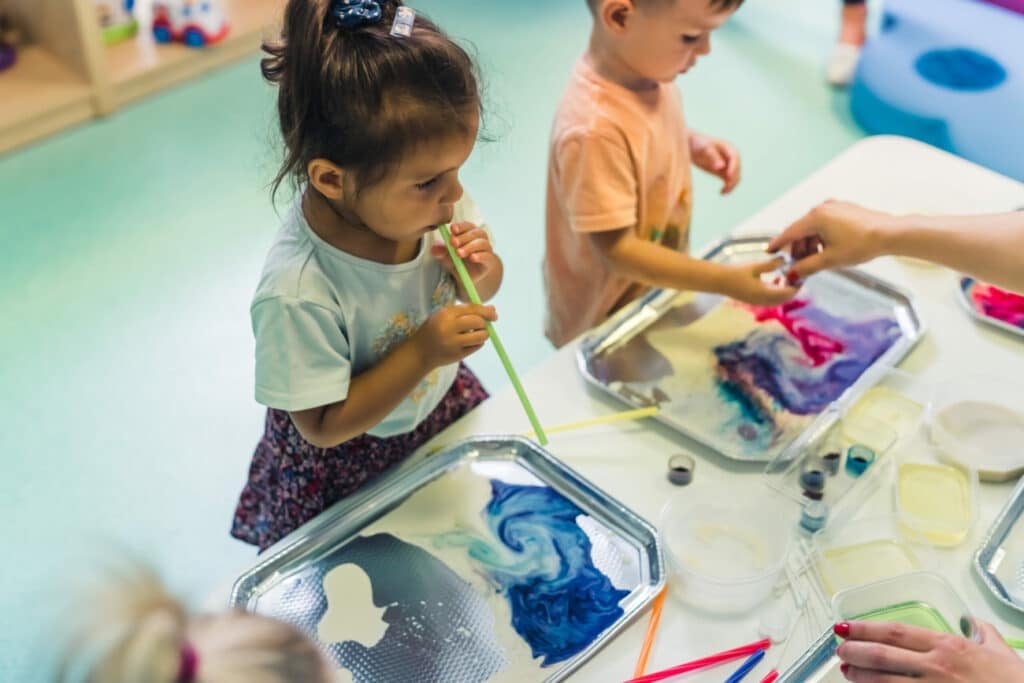Education is an important aspect of our lives, providing the foundations that helps us acquire knowledge and skills necessary for our personal and professional growth. A school’s approach to education will vary from continent to continent, country to country and even town to town. Hands-on learning has proven to be one of the most effective methods for helping students develop practical skills and retain information. It is the process of learning by actually experiencing something first-hand, rather than just being told about it. The term “hands-on” involves active participation rather theoretical study – for example children might use manipulatives such as cubes for counting or volume in maths and exploring leaf colour and texture for a piece of autumnal poetry.
Hands-on learning is particularly important for young children, as this is how they are shaped to learn. Children learn from observing, repetition, and exploring with their hands and body as soon as they are born, and play continues to be the most important way of learning new skills until they reach school age. Later on in this blog, we delve into the approaches taken by education in Sweden and Finland to support claims for a more hands-on classroom culture. For now, let’s outline the benefits further.
Promotes Engagement
One of the key benefits of hands-on learning is that it encourages engagement and participation. When students are able to physically interact with the material they are learning, they are more likely to pay attention and as a result, develop their long-term memory. Hands-on activities also help to break up the monotony of traditional lecture-style learning, which can be boring for many students. For example, teaching the alphabet and basic letter forming skills can quickly become tedious for young children with traditional pencil and paper or flashcards.

Instead, allowing them to use a tray of sand or shaving foam to trace out letters with their fingers, or providing play-dough or clay to form the letters is a fun activity that will be exciting and effective.
This increased engagement leads to a higher level of student motivation, which can result in a better understanding of the concepts being taught.
Provides Real-World Experience
Hands-on learning allows students to apply what they have learned in a practical setting, which can help to embed their understanding of the concept. For example, if a student is learning about engineering, they might build a bridge using different materials and test its strength. This type of hands-on learning provides students with a deeper understanding of the material and helps them see how it applies to the real world. No matter how many books we read, or videos we watched, learning to drive a car is impossible without a hands-on approach. If your school has the capacity to turn every day, mundane tasks into experiential ones, your students will throw themselves into their learning and everyone benefits.
Develops Critical Thinking Skills
Hands-on learning also helps to develop critical thinking skills. When students are given the opportunity to experiment and problem-solve on their own, they are forced to think critically and creatively. This type of learning helps students develop the skills necessary to analyse, evaluate, and make informed decisions. When multiple activities such as talking, listening, and using the hands are combined, it activates more areas of the brain than a single activity’ helping to support learning and recollection in the same way that multi-sensory play does. It is often suggested that the children of today will be the ones solving the world’s issues of the future. To enable then to have a chance, we must provide the with ample opportunities as early as possible to develop their cognitive understanding of the subject material and social skills. Through group activities, students learn how to find solutions diplomatically, delegate, and work as part of a team.
Fosters Creativity
‘Creativity’ is a muscle. Like any other, without work, it very quickly forgets how to function. The utterance of the word in a classroom immediately takes students to thoughts about art or music. However, creativity isn’t subject dependant – it is a trait we all have that can be developed. When students are given the opportunity to experiment and explore, they are able to tap into their imagination and come up with innovative solutions to problems. This type of learning helps students develop their creative problem-solving skills, which are essential for later in life. Schools attempt to tackle this by embedding a mastery approach into their curriculum; an approach whereby students are taught until a concept is fully embedded before moving into a new area. For example, long division in maths will require repetition of calculation but also practical and visual solutions to more abstract problems. Only then, is long division learnt.
Active learning around the world
In recent times, some schools in Sweden have adopted a more proactive approach to students’ learning by handing the process over them. “Active learning is very child-centred because the students themselves have to participate in the process of their learning,” said Ejike Onwueme, teacher at SSHL in Stockholm. As a result, shy students are more engaged and teachers have observed more open-minded children. Science students have been noticeably more passionate about the subject, not by rummaging in the dirt of the school field for rocks, but by debating and sharing ideas in open-forum discussions. This demonstrates that hands-on learning is wide-ranging and flexible.
Finland boast impressive results in light of huge educational reform with students achieving the highest across Europe across reading, maths and science. How do they do it? Children learn through play in Finland until they begin formal lessons aged seven – three years later than most countries. Also, students are not tested for the first six years of education, with the only mandatory assessment taken at the end of secondary school.
To conclude
Hands-on learning is an essential aspect of education that provides students with a unique and effective way to learn. By promoting engagement, providing real-world experience, developing critical thinking skills, and fostering creativity, hands-on learning helps students acquire the knowledge and skills necessary for their personal and professional growth.
About the author

Andrew Timbrell
Education writer with over a decade of experience in the sector as a teacher and senior leader.










